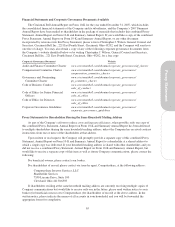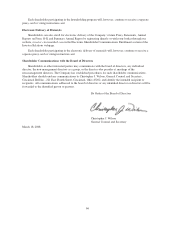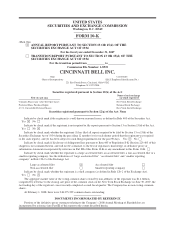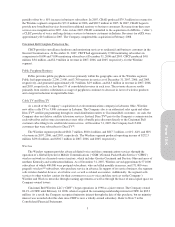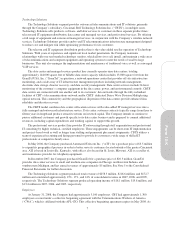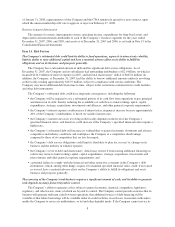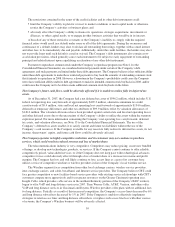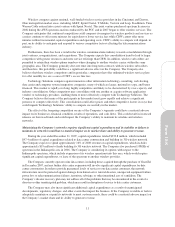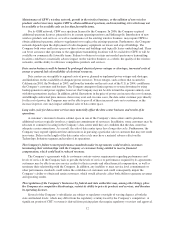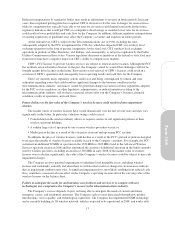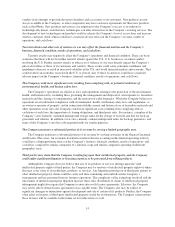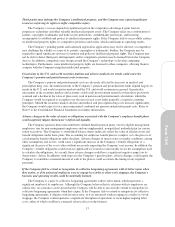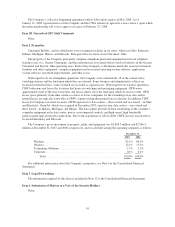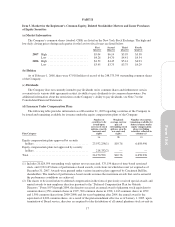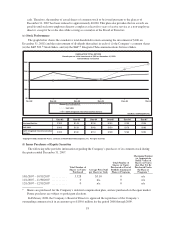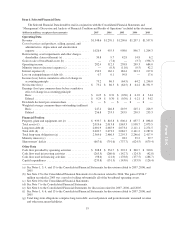Cincinnati Bell 2007 Annual Report Download - page 89
Download and view the complete annual report
Please find page 89 of the 2007 Cincinnati Bell annual report below. You can navigate through the pages in the report by either clicking on the pages listed below, or by using the keyword search tool below to find specific information within the annual report.
indebtedness, it will have to take actions such as reducing or delaying capital expenditures, strategic acquisitions,
investments and joint ventures, selling assets, restructuring or refinancing indebtedness, or seeking additional equity
capital, which may adversely affect its customers and affect their willingness to remain customers. The Company
may not be able to negotiate remedies on commercially reasonable terms, or at all. In addition, the terms of existing
or future debt instruments may restrict the Company from adopting any of these alternatives.
The Company depends on the receipt of dividends or other intercompany transfers from its subsidiaries.
Certain of the Company’s material subsidiaries are subject to regulatory authority that may potentially limit
the ability of a subsidiary to distribute funds or assets. If the Company’s subsidiaries were to be prohibited from
paying dividends or making distributions to Cincinnati Bell Inc. (“CBI”), the parent company, CBI may not be
able to make the scheduled interest and principal repayments on its $1.8 billion of debt. This would have a
material adverse effect on the Company’s liquidity and the trading price of the Cincinnati Bell common stock,
preferred stock, and debt instruments.
The Company’s creditors and preferred stockholders have claims that are superior to claims of the holders of
Cincinnati Bell common stock. Accordingly, in the event of the Company’s dissolution, bankruptcy, liquidation, or
reorganization, payment is first made on the claims of creditors of the Company and its subsidiaries, then preferred
stockholders and finally, if amounts are available, to holders of Cincinnati Bell common stock.
The Company depends on its credit facilities to provide for its financing requirements in excess of amounts
generated by operations.
The Company depends on its credit facilities to provide for temporary financing requirements in excess of
amounts generated by operations. As of December 31, 2007, the Company had $55.0 million of outstanding
borrowings under its revolving credit facility and had outstanding letters of credit totaling $27.1 million, leaving
$167.9 million in additional borrowing availability under its $250 million revolving credit facility. The ability to
borrow from the credit facilities is predicated on the Company’s compliance with covenants. Failure to satisfy
these covenants would constrain or prohibit its ability to borrow under the credit facilities. As of December 31,
2007, the Company was in compliance with all of the covenants of its credit facilities.
The credit facilities and other indebtedness impose significant restrictions on the Company.
The Company’s debt instruments impose, and the terms of any future debt may impose, operating and other
restrictions on the Company. These restrictions affect, and in many respects limit or prohibit, among other things,
the Company’s ability to:
•incur additional indebtedness;
•create liens;
•make investments;
•enter into transactions with affiliates;
•sell assets;
•guarantee indebtedness;
•declare or pay dividends or other distributions to shareholders;
•repurchase equity interests;
•redeem debt that is junior in right of payment to such indebtedness;
•enter into agreements that restrict dividends or other payments from subsidiaries;
•issue or sell capital stock of certain of its subsidiaries; and
•consolidate, merge, or transfer all or substantially all of its assets and the assets of its subsidiaries on a
consolidated basis.
In addition, the Company’s credit facilities and debt instruments include restrictive covenants that may
materially limit the Company’s ability to prepay debt and preferred stock. The agreements governing the credit
facilities also require the Company to achieve and maintain compliance with specified financial ratios.
9
Form 10-K


